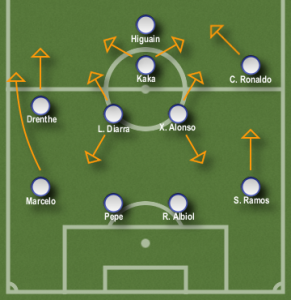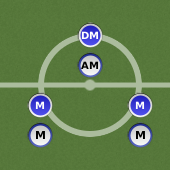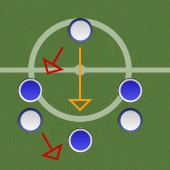Last time around I showed you the gaping holes in my tactical plan. Against smaller teams, my players were not imposing themselves enough on the game, nor were they able to break through more disciplined defences. What was the solution? Pressure – and lots of it.
Tactical Plan v. 3.0
I wanted to stick to the “4-3-3” principal of my original tactic but allow it to be flexible enough to cope with different situations. The solution was a slightly modified version of the “dominate” tactic – the “withdrawn” formation, with the left winger encouraged to run from deep into the attack. The thinking behind this was that a quick winger such as Drenthe or Marcelo would have more joy taking a run up at the opposing full back rather than sitting on his shoulder and waiting for space to become available. Thus, the AML became a ML defensive winger with an attack duty.
The second part of the change came in the centre of the midfield. Putting pressure on deeper lying midfielders was key, but it was also important that my midfielders did some creative work as well. So I put them both on support duties as ball winning midfielders. They would heavily press the central midfield, but also be in a position to join attacking moves and play some good balls through when needed.
Finally, to give some width and some more men in support of the attackers I made both of my full backs wing backs with an automatic duty.
The Short Story

By making these changes, the team did indeed regain control of the centre of the field. By using Diarra and Alonso as ball-winning midfielders on support duty, the opposition’s midfield were unable to exploit spaces. Both players would track forward or backwards depending on where the opposition were. This was a huge defensive benefit and meant that when playing counter attacking teams we could effectively break up any possession before it built up momentum.
Ronaldo and Kaka continued to cause problems at the front, and the centre forward continued to score goals. Drenthe, from a more reserved position, offered not only defensive stability but a deeper attacking option. Both Ramos and Marcelo got their fair share of crosses in as well. All looked good.
This solved the problem when I played against deeper lying teams. But there was one type of team which were still causing me problems. Those playing 4-2-1-3. This system does not match up against a 2-1 midfield. Versus 4-1-2-3 sides, such as Barcelona from chapter 3, my midfield matched up exactly. The MCs take on the opposition’s MCs, and my AMC can hassle the DMC. That’s fine. But against the 4-2-1-3, the opposition’s playmaking “number 10” can play in between my MCs, while my AMC is left with two central midfielders to close down.
While partly we can try to blame the flawed marking logic in FM10, there is an inherent weakness here which needed to be addressed.


As you can see, the 2-1 midfield I had set up naturally marked the 1-2 midfield of the traditional 4-3-3. Against a 4-4-2, it also had a man spare. Where it fell down was when it came up against a similar shaped midfield.
In these circumstances, the players have two options. Either they can follow the red arrows (where my AMC tracks to the one MC and one of my MCs tracks back to their MC) or they can follow the orange arrows (where my AMC matches up against their AMC).
Unfortunately, the logic in the FM2010 ME favours the orange solution. This is doubly disadvantageous. First, it means Kaka, my creative outlet, spends most of his time running away from his hole to cover the defence; and second Kaka is not fit enough or defensively minded enough to perform well in this role. The entire of the team’s shape is ruined.
The second solution, then, was to play the same system but with three MCs. Kaka dropped back into the midfield as an advanced playmaker in the MCc slot. This reduced the amount of distance he had to track back whilst protecting him in a little “hole”, flanked as he was on both sides by ball-winning midfielders.
Success?
In very brief terms, it solved my problem short-term. We went on to put together the wins which eventually saw us win the league title (with 89 points – four more than Barca). I used these systems in the second season, resorting only to the “counter” strategy when playing against sides who I expected to cause me problems. Again, we retained the league, getting 97 points in the process (12 more than Barca).
Cristiano Ronaldo was played in a way which perfectly suited him. His 39-goal tally from season one was followed by 52 goals in the second season. Kaka made the most assists in the league in both seasons with 17 and 14 (20 and 21 in all competitions). For a 38-game league campaign, I now had all the tools to win the league comfortably with the talent at my disposal.
In the Champions League, however, I still came up short. A quarter final defeat to Porto on away goals was followed a season later by a semi final defeat to Internazionale. Mourinho defeats Mourinho.
I will follow up by writing a bit about these defeats in the next article, and try to analyse where my system did well and where it fell apart.
The Benefit of Hindsight
For those of you following these articles on the forums, you’ll know that I played this save many weeks ago. As such, a World Cup has been and gone and a new football season has started. This has given me a number of fresh ideas for how I might have approached this differently.
As SFraser has pointed out to me, player attributes are an important part of the tactical set up. In many cases, it was clear that I had developed the system from the formation to the players rather than taking the players and making the formation. Without doubt, Kaka, Ronaldo, Higuain/Benzema and the two centre backs were ideally suited to this style of football. However, the midfield needed some work on it.
I have since taken up the save again in season 3 and am working on a slightly different system. This is based more around the players I have and the players I can hire. I will begin to show you this in a few weeks’ time.
Conclusions
This new system did a job. Arguably, it did more than that; two league titles are not to be sniffed at, and victories at Stamford Bridge, the San Siro and Camp Nou suggest that the general pattern of play worked. However, there were still holes which meant that in Europe especially the team could be found wanting. It is those problems I hope to address now.

Comments are closed